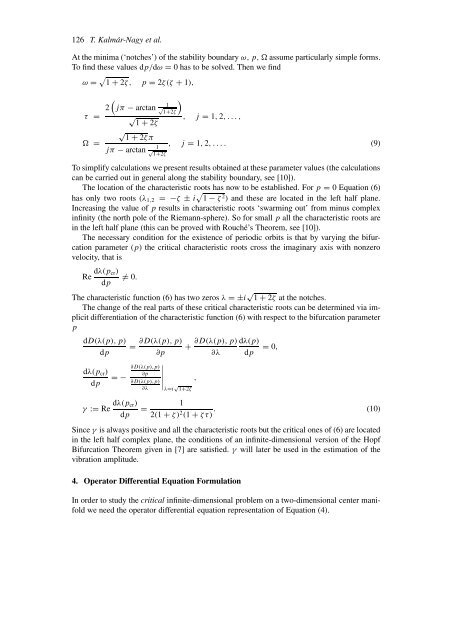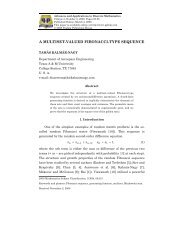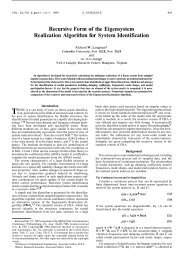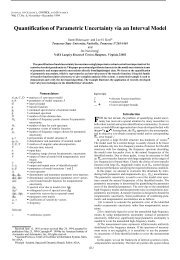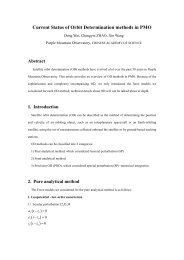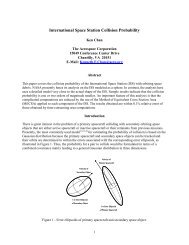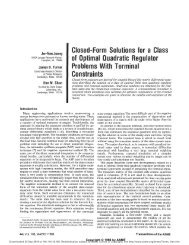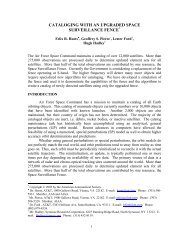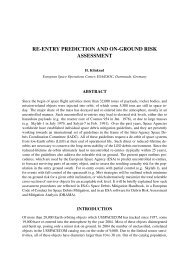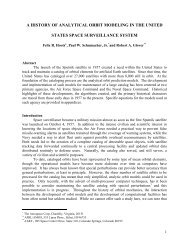Subcritical Hopf Bifurcation in the Delay Equation Model for Machine ...
Subcritical Hopf Bifurcation in the Delay Equation Model for Machine ...
Subcritical Hopf Bifurcation in the Delay Equation Model for Machine ...
You also want an ePaper? Increase the reach of your titles
YUMPU automatically turns print PDFs into web optimized ePapers that Google loves.
126 T. Kalmár-Nagy et al.At <strong>the</strong> m<strong>in</strong>ima (‘notches’) of <strong>the</strong> stability boundary ω, p, assume particularly simple <strong>for</strong>ms.To f<strong>in</strong>d <strong>the</strong>se values dp/dω = 0 has to be solved. Then we f<strong>in</strong>dω = √ 1 + 2ζ, p = 2ζ(ζ + 1),τ = =(2)√11+2ζjπ − arctan√ 1 + 2ζ, j = 1, 2,...,√ 1 + 2ζπ, j = 1, 2,.... (9)1jπ − arctan √ 1+2ζTo simplify calculations we present results obta<strong>in</strong>ed at <strong>the</strong>se parameter values (<strong>the</strong> calculationscan be carried out <strong>in</strong> general along <strong>the</strong> stability boundary, see [10]).The location of <strong>the</strong> characteristic roots has now to be established. For p = 0 <strong>Equation</strong> (6)has only two roots (λ 1,2 = −ζ ± i √ 1 − ζ 2 ) and <strong>the</strong>se are located <strong>in</strong> <strong>the</strong> left half plane.Increas<strong>in</strong>g <strong>the</strong> value of p results <strong>in</strong> characteristic roots ‘swarm<strong>in</strong>g out’ from m<strong>in</strong>us complex<strong>in</strong>f<strong>in</strong>ity (<strong>the</strong> north pole of <strong>the</strong> Riemann-sphere). So <strong>for</strong> small p all <strong>the</strong> characteristic roots are<strong>in</strong> <strong>the</strong> left half plane (this can be proved with Rouché’s Theorem, see [10]).The necessary condition <strong>for</strong> <strong>the</strong> existence of periodic orbits is that by vary<strong>in</strong>g <strong>the</strong> bifurcationparameter (p) <strong>the</strong> critical characteristic roots cross <strong>the</strong> imag<strong>in</strong>ary axis with nonzerovelocity, that isRe dλ(p cr)̸= 0.dpThe characteristic function (6) has two zeros λ =±i √ 1 + 2ζ at <strong>the</strong> notches.The change of <strong>the</strong> real parts of <strong>the</strong>se critical characteristic roots can be determ<strong>in</strong>ed via implicitdifferentiation of <strong>the</strong> characteristic function (6) with respect to <strong>the</strong> bifurcation parameterpdD(λ(p),p)dpdλ(p cr )dp= ∂D(λ(p),p)∂p∂D(λ(p),p)∂p=−,∣ √ λ=i 1+2ζγ := Re dλ(p cr)dp∂D(λ(p),p)∂λ=+ ∂D(λ(p),p) dλ(p)∂λ dp = 0,12(1 + ζ) 2 (1 + ζτ) . (10)S<strong>in</strong>ce γ is always positive and all <strong>the</strong> characteristic roots but <strong>the</strong> critical ones of (6) are located<strong>in</strong> <strong>the</strong> left half complex plane, <strong>the</strong> conditions of an <strong>in</strong>f<strong>in</strong>ite-dimensional version of <strong>the</strong> <strong>Hopf</strong><strong>Bifurcation</strong> Theorem given <strong>in</strong> [7] are satisfied. γ will later be used <strong>in</strong> <strong>the</strong> estimation of <strong>the</strong>vibration amplitude.4. Operator Differential <strong>Equation</strong> FormulationIn order to study <strong>the</strong> critical <strong>in</strong>f<strong>in</strong>ite-dimensional problem on a two-dimensional center manifoldwe need <strong>the</strong> operator differential equation representation of <strong>Equation</strong> (4).


